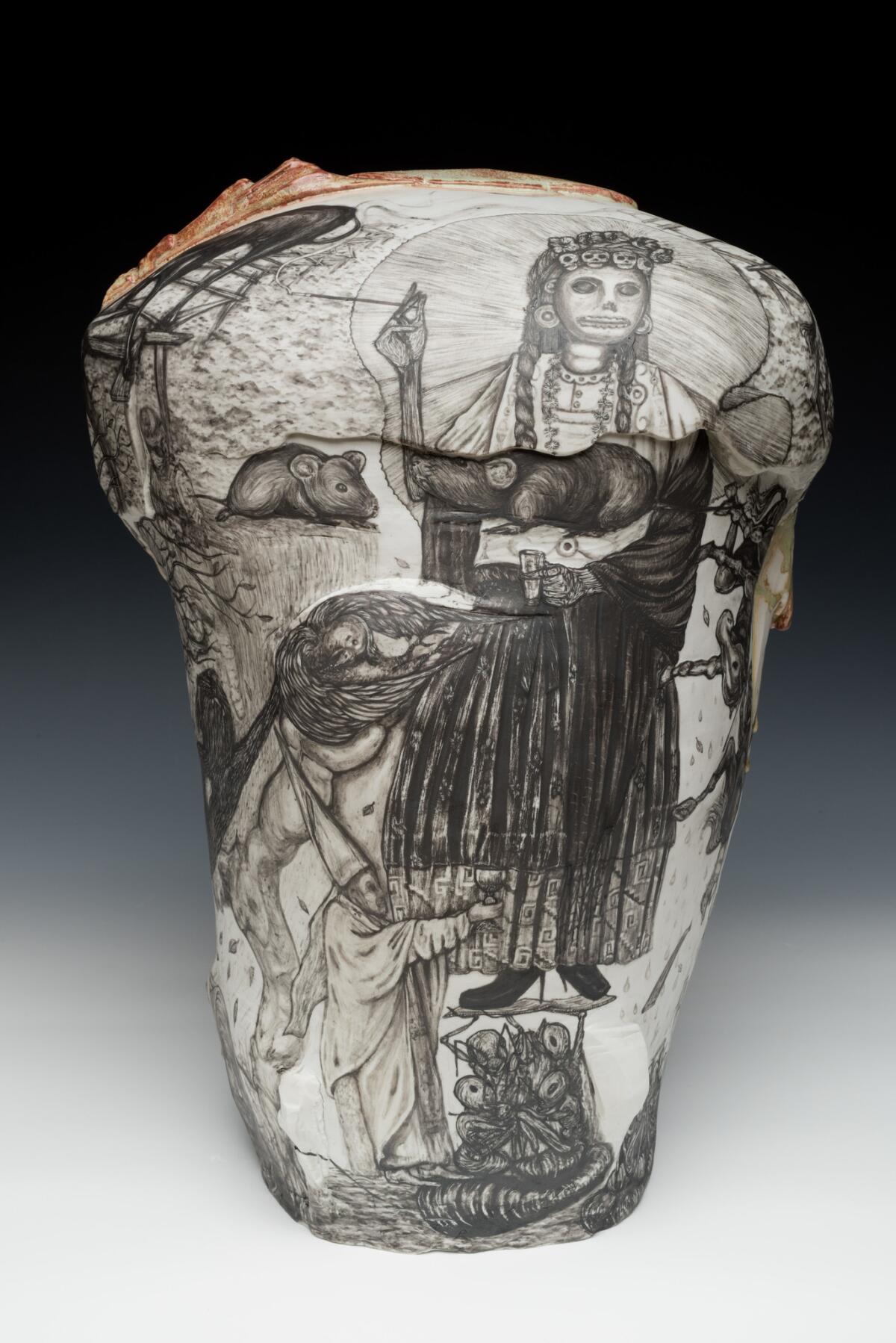Review: Gerardo Monterrubio’s ‘Mano-Made’ works: A swirling vortex of lives, captured on clay
Gerardo Monterrubio's sculptures could easily be called riveting or arresting, except that would imply that they stop you in your tracks and hold you fast. His work does the opposite: It compels movement.
To experience each sculpture requires eddying around it, succumbing to its powerful centripetal force. The dense, urgent imagery on its rugged surfaces doesn’t stop, and neither might you.
A dozen of the Oaxaca-born, Los Angeles-based artist’s recent works are on view at the Craft in America Center in the second of its three-part Pacific Standard Time series, “Mano-Made: New Expression in Craft by Latino Artists.”
Monterrubio favors porcelain, and lately also terra cotta, starting with mounds of wet clay that he pummels with a stick to compress the material and also to season it, in a sense, to give it texture and irregularity. The resulting forms, most measuring around 2 feet in height, suggest hefty vessels like urns, or broad-shouldered, thick-chested torsos. One, nominally a teapot, has a crude spout and fat fin of a handle, but its lid is fixed in place.
Monterrubio matches the intensely physical process of forging these shapes with an equally insistent skin of images, a continuous montage of scenes drawn from observation, memory and imagination.


SIGN UP for the free Essential Arts & Culture newsletter »
“Puño de Tierra (Fist of Earth)” typifies the relentlessly vigorous, cinematic rush of images. A milky greenish glaze falls in two discrete trails down the sculpture’s sides, but the teeming surface is predominantly monochromatic, drawn with an underglaze pencil in tones of graphite and ash. There is a large, Aztec goddess of death wearing a garland of skulls and flowers. In one bony hand, she extends a smoking cigarette holder, and in the other, an upended salt shaker. Whatever poured from it would land in the chalice held aloft by a papal figure below.
Nearby, a horse kicks free from its corral. Either it joins the stampede of others along the pot’s shoulder, or tumbles downward, as if in stop-motion animation. Both options are articulated, however mutually exclusive. Much more unfurls, involving a serious clown, a sinister dog, a marching band, an armed soldier.
Violence, sex, death, faith, ritual — all play out in interwoven vignettes that jumble time and scale, the mythic and the every day. Monterrubio cites the Mexican muralists as an influence (the sensibility of David Alfaro Siqueiros runs strong), as well as prison tattoos and graffiti. The work also has a strong whiff of German Expressionism, and resonance with the dark, throbbing Tijuana cityscapes of Hugo Crosthwaite. Monterrubio quotes directly from Hokusai in one spot, and from Mimbres pottery in several others.
Each piece serves as a surface for drawing, but not like an uninterrupted sheet of paper or stretched canvas. The sculpted forms have rough topographies of their own — ridges, cracks, bumps — akin to the internal texture of a life, never entirely smooth, somewhat unpredictable and all the more genuine for its honest incoherence. Monterrubio's sculptures chronicle his own particular experience, but also, more broadly, the disjunctive immediacy and vital rush of being.
Craft in America Center, 8415 W. 3rd St., Los Angeles. Through Nov. 25; closed Sundays and Mondays. www.craftinamerica.org

See all of our latest arts news and reviews at latimes.com/arts.
MORE ART:
Painter Ellen Gallagher: How African slaves went from human to cargo
The biggest entertainment stories
Get our big stories about Hollywood, film, television, music, arts, culture and more right in your inbox as soon as they publish.
You may occasionally receive promotional content from the Los Angeles Times.



